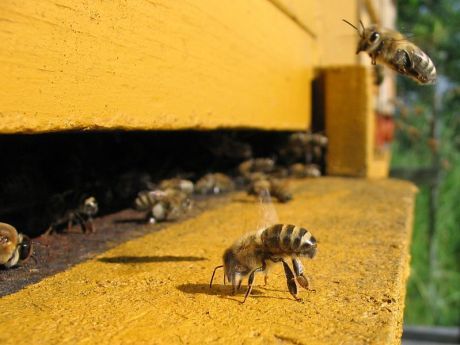News
You are here
Bees dying for profits

August 24, 2013
Over the winter of 2012 – 2013, forty to fifty percent of American beekeepers' hives were destroyed by colony collapse disorder. This is after almost a decade of 30 percent losses each winter. Before then around ten percent of the hives would perish each year. Bees and other insect pollinators are necessary for 78 per cent of flowering plants to reproduce and 70 of the 100 crops that provide 90 percent of our food are pollinated by bees. Without bees our ability to grow food will be compromised.
A peer-reviewed study published in late July has determined that consistent exposure to sub-lethal doses of pesticides in combination with other factors – habitat destruction, parasites and climate change – are combining to lead to the honey bee colony collapses and the deaths of millions of bees documented since 2006. This is a serious and complex problem that appears to have several contributing causes.
While it has been known for a few years now that one class of crop pesticides – the neonicotinoids introduced in the 1990s – is linked to honey bee colony collapse, the study in the journal PLoSONE also found fungicides and miticides playing a role as well. Prior to this study, fungicides had not been strongly connected; and the miticide in question is one used by beekeepers to kill the Varroa mite that feeds on the honey bees’ blood.
These pesticides do not kill the bees outright. Instead, they affect their survivability. The effects of consistent exposure include: altered development, mobility, feeding behaviour, navigation and orientation, and immune function. The effects to navigation often prevent honey bees from returning to their home hive; affected immune function makes honey bees more susceptible to infection by the gut parasite Nosema ceranae. Once affected by the parasite, honey bees do not overwinter well, perform poorly in the spring, and the colony faces queen replacement and accompanying stresses until a new queen is established.
Neonicotioids are nicotine-related pesticides used extensively on grain crops, and which affect the nervous system in honey bees. Based on studies that had already been completed, in early 2013 the European Union voted to suspend use of all neonicotinoid pesticides for two years. Canadian farmers have resisted a ban on the pesticide, insisting it has been incredibly beneficial to crops since its introduction in 2004. Farmers estimate a crop loss of two to 13 percent of their gross income should neonicotinoid use be banned. This is in spite of evidence of colony deaths coinciding with corn-planting season, and with contamination of fields visited by bees exposed to the pesticide but not directly sprayed by it.
As honey bees are responsible for pollination of one-third of the world’s food crops, further research and action to protect both the grain and bee-pollinated food crops, not to mention the livelihoods of farmers, are urgently needed. However, this research must be done without the lobbying of governments by pesticide producers such as Bayer and Syngenta to maintain integrity of the results. Profits of pesticide producers should not be more important then maintaining the security of the food supply.
Section:
Topics:










